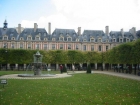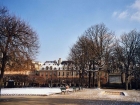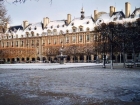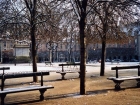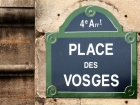Neighborhood
We're Moving!
Our website has a new home.
Please visit our new site by clicking the link below:
Paris around Hotel de la Place des Vosges
Our hotel, which dates back to 1605, is situated at 12 Rue de Birague in the oldest district of Paris; now part of the 4th arrondissement. The area includes the southern part of the medieval Marais, as well as the lie St-Louis and part of Ile de la Cite. Marais, which means "swamp" and once was, fell from royal stomping grounds to shambles after the French Revolution. Since its revival in the 1960's, it has become a center of Parisian artistic and cultural life. It's one of the only areas that preserves the narrow streets and architectural styles of Medieval and Renaissance-era Paris. (Most of Paris was drastically overhauled in the mid-19th century under the direction of Napoleon Ill and architect Baron Haussmann.)A half-block north of the hotel is the entrance to Paris' oldest and loveliest squares, Place des Vosges. Its brick and stone houses built over arcades bear witness to Henri IVs interest in town planning. The square originally housed the royally owned Hotel de Tournelles, where both Charles VII and Louis XIII lived. in the early 17th century, Henri IV's demands for an opulent residence within the city lead to the construction of the Place des Vosges, then called the Place Royale. In the 19th-century Victor Hugo lived at #6; The Hugo Museum is located there today. The Place des Vosges is a popular site for relaxing, strolling and dining. It contains fine art galleries, pricey restaurants and classical musicians who set up shop and attract large crowds. The small park in the center of the square is one of the few places in Paris where you can sit on the grass, unless there are signs reading "Pelouse en Repos" (the lawn is resting)!The square is within easy walking distance of a number of high profile monuments and attractions such as the Place de La Bastille, Picasso Museum, Notre-Dame, St. Paul-St. Louis Church (Louis XIII laid the first stone), the gothic bell tower of Tour St-Jacques, Ile St-Louis, Ile de la Cite and Saint Chapelle. Contrasting with all the historic buildings is the modern Centre Pompidou.Additionally the neighborhood is replete with fascinating out-of-the way places that tourists often miss. About a block west of the square, at the corner of Rue de Sévigné and Rue des Francs-Bourgeois is the Musée Carnavalet, also known as The Museum of the History of Paris. It's one of the city's many free museums, and the permanent collection here is outstanding. On the Rue des Francs-Bourgeois side of the building, you can peek through the decorated iron gates into its lavish formai gardens. In the courtyard stands a magnificent sculpture of Louis XIV. Inside the museum, the exhibits trace the transformation of the village of Lutece, which was inhabited by the Paris tribes, to modern Paris.
The Carnavalet houses a huge collection of paintings, drawings, photographs, sculptures and decorative arts, coins, archeological fragments etc. It is renown for its images of the city and portraits of characters who played a role in the city's history. Some highlights of the exhibits include: canoes dating back to before the first written description of the village in A.D. 52 in Julius Caesar's De bello Gallico, personal effects belonging to Marie-Antoinette, Napoleon's favorite case of toiletries, a painting of the construction of the Statue of Liberty, which was shipped to America in pieces. and photographs of 20th-century Paris by Eugene Atget and Henri Cartier-Bresson. (The entrance is at 23, Rue de Sevigné. Open 10 to 6).Rue des Francs-Bourgeois, once a street where artisan weavers worked, remains a major center of fashion and design and one of the Marais' most popular shopping areas. It also houses some impressive, but often overlooked, Renaissance-era buildings. Take time to browse some of the fashion and jewlery boutiques here and to admire the historic residences. A block or so beyond The Carnavalet (north on Rue Elzévir), a handsome private mansion presents an exceptional art collection of the 18th century: Musee Cognacq-Jay displays paintings by Boucher, Chardin and Fragonard, drawings by Watteau, sculptures and furniture and objets d'art (jewels, snuffboxes, china, etc.) collected by the creators of the Samaritaine department store. (Open 10 - 5.40 every day except Monday.)Rue Vieille du Temple (about 5 blocks west of Place des Vosges) is the artery of Marais nightlife with lots of charming, quirky bars and restaurants! South of Rue des Francs-Bourgeois is the historic Jewish quarter, Rue des Rosiers. Large Jewish communities have lived here on and off since the 13th century. At the constant mercy of kings who periodically expelled them from France, Jews only acquired a measure of stability in the early 19th century. During WWII, the neighborhood was targeted by the Nazi occupation and the collaborationist French police. Today, the street and surrounding neighborhood is well-known for its delicious Middle Eastern and Yiddish/Eastern European specialties. Especially recommended are L'as du Falafel (32 Rue des Rosiers) claiming the "best falafel in the world" and Sacha Finkelsztajn (27 Rue des Rosiers), which offers delicious Yiddish baked goods.Just behind Saint Paul Church, between the noisy Rue de Rivoli and the busy road bordering the Seine is Saint-Paul Village. This tiny block of houses with stone streets is entirely pedestrian and accessible only through arched passageways. The passageways bring you into a series of quiet, interconnected courtyards where visitors will find art galleries, fine antiques, food shops, and artisan boutiques. Dealers and collectors count the Village Saint-Paul as one of the best spots in Paris for finding treasures of historical importance.






